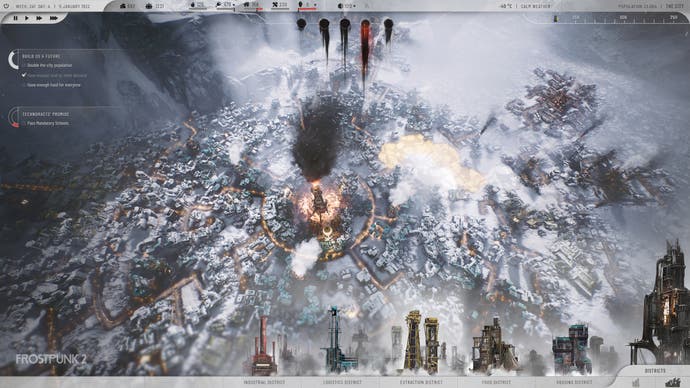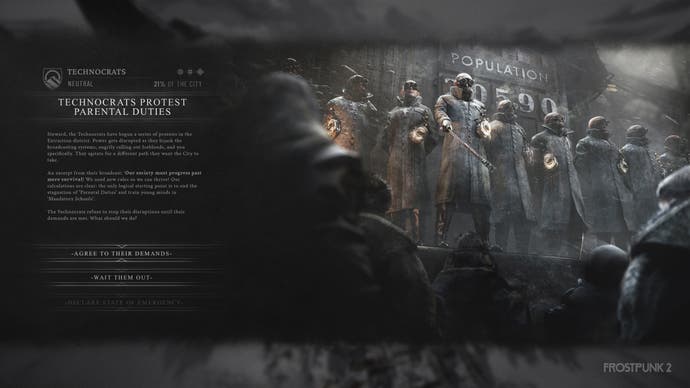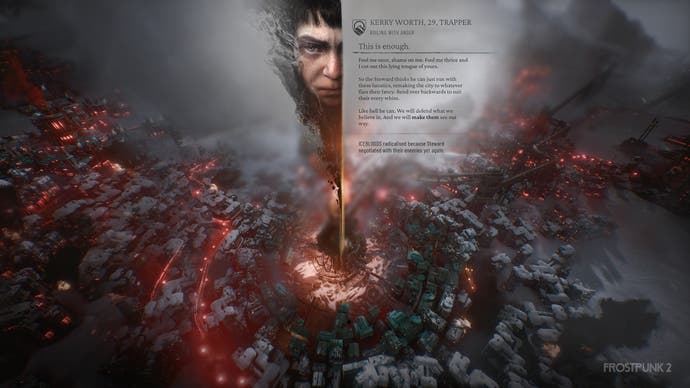Weather is no longer the primary threat in Frostpunk 2 - people are
It's a riot.
In a remarkable display of good timing, we are currently giving away Frostpunk 1 game keys to yearly supporters of Eurogamer.
At a glance, Frostpunk 2 looks quite a lot like Frostpunk 1, and I was actually relieved to see this because the silence has been such around the sequel I honestly wasn't sure what to expect. It could have been anything. But it's not; it's familiar. We're still building a Victorian-style city in the snow, and it still looks very cold out there. Look more closely, though, and there are some surprisingly profound differences underneath.
The biggest immediate change is that the weather - the extreme cold - is no longer your major concern in the game. It's still there, you're still in a frozen wilderness and it's still a contributing factor to the pressurised situation you're in - as is having enough food for your city and staving off disease - but you won't spend the game as preoccupied by it, or by an apocalyptic storm that's rolling in.
Instead, you'll spend your time preoccupied by a storm of a different kind. A people-shaped storm, a societal storm. And if you fail to manage that properly, it will end you.
Frostpunk 2 is more political because of it, which I know sounds like a bold statement given that Frostpunk 1 was entirely about how far you'd go - politically speaking - to save a colony from extreme cold. Would you enact brutal dictatorial powers for what you perceived to be the greater good? That was the whole premise of the game. But this time, though, the politics are more detailed and life-like.

The big difference is in Frostpunk 2 you can no longer pass laws on your own. You can't just suddenly decide to outlaw child labour, for example - or to enforce it. You are still the leader of the settlement you're building, the person in charge, but if you want to pass a law, you will now need people to vote on it - people who belong to factions or parties within your settlement whose views might not (probably will not) match your own.
The factions I see in my hands-off demo are the Foragers and the Engineers, who have diametrically opposed ideas about how to deal with the challenges ahead. One believes technology is the answer, whereas the other doesn't trust it at all. Convincing one faction to side with you, then, often ends up aggravating the other. Also, convincing a faction will usually entail meeting their demands in return - rarely will it ever be as simple as them standing alongside you. In this way, one deal can easily fan out into several more.
All of this political manoeuvring takes place in a brand new building called the Council. And it's so important to the game that for the first time in the series, you can go inside it. You'll see from a bird's eye view a chamber full of people sitting in pews and shuffling around, as if in a kind of Parliament - actually, the whole feature feels very reminiscent of Parliament. And here, you'll find menus showing how many people are currently For and Against what you're proposing, and what you can do to manipulate them your way.

You begin to see, then, how a web of political promises can quickly build in the game and entangle you if you're not careful - and perhaps, even if you are. And it's here where the real threat and difficulties of Frostpunk 2 come in. Betray your promises and you'll start to see these factions turn against you, and they'll start speaking out against you at rallies and protests across the city. And if you allow their support to build, and the spherical gauge to fill (where the Hope and Discontent gauges used to be), you will face a coup and see the ominous "The City Must Not Fall" words (in place of the first game's "The City Must Survive") and it will be game over, and you'll have to try again.
That's the major thematic difference in the game. There are, though, other very notable changes too. Another immediate one is the scope of Frostpunk 2. You'll see straight away that cities can grow much larger in the sequel than in Frostpunk 1; you'll begin with a city that's roughly the size of the one you ended the original game with. And, cities are much quicker to build now. It's because in Frostpunk 2, you don't place buildings individually but in bulk. You designate entire areas to become districts for Food or Housing or Industry or Logistics or Extraction, and then that's what happens there (and there are pros and cons to placing certain districts next to each other).

Similarly, because of this, you no longer deal in petty amounts of resources - in arms full of coal or wood. In Frostpunk 2, you begin with the ability to mass-excavate resources. And, the game no longer inches forward day by day but week by week, allowing time to pass much more quickly. It's a game that takes a more zoomed-out perspective on city-building and assumes you've overcome the initial hurdle of establishing a settlement in the cold, and are now concerned with what happens in the years that come next.
Despite this, the important individual touches are still there. You'll still hear from individuals about the problems they face day to day in your society, and see the consequences your actions are having on them. Make children work, for instance, and you'll see up close what happens to them because of it. You won't be spared the harsh realities because this, after all, is what Frostpunk is about.
Frostpunk 2 has also moved engine to Unreal 5, though it doesn't appear startlingly different because of it. There is a more lavish feel to it, though. Bulky mounds of snow teeter on rooftops, there's a long-exposure-like blurring of lights along roadways to evoke time and activity going by, and everywhere there's evidence of a larger team at work - tidier menus, cleaner graphical presentation. The resource tree alone - now the Idea Tree - has expanded massively.

It's an exciting glimpse of the game, then, but it is still only a glimpse. I don't know how it actually feels to play, nor do I have a sense of how the more complicated political manoeuvring will affect the game. Will it actually be fun to play around with or will it feel fussy and too much like political wrangling in real-life?
More importantly, I have no idea what the main aim of the game is. In Frostpunk, you clung on as an apocalyptic storm rolled in, plunging temperatures down to minus 100 degrees centigrade. Here? I'm not sure what you're trying to survive. We aren't even allowed to know what the win conditions are in the more free-form Utopia game mode being demoed.
It's a cautious reveal, then, but it's a reassuring one too. This is Frostpunk, back in abundance, deeper, broader and more nuanced than before. I'm eager to see and hear more in the build up to the game's first-half of 2024 release.
Just to reiterate: we are currently giving away Frostpunk 1 game keys to yearly supporters of Eurogamer.

